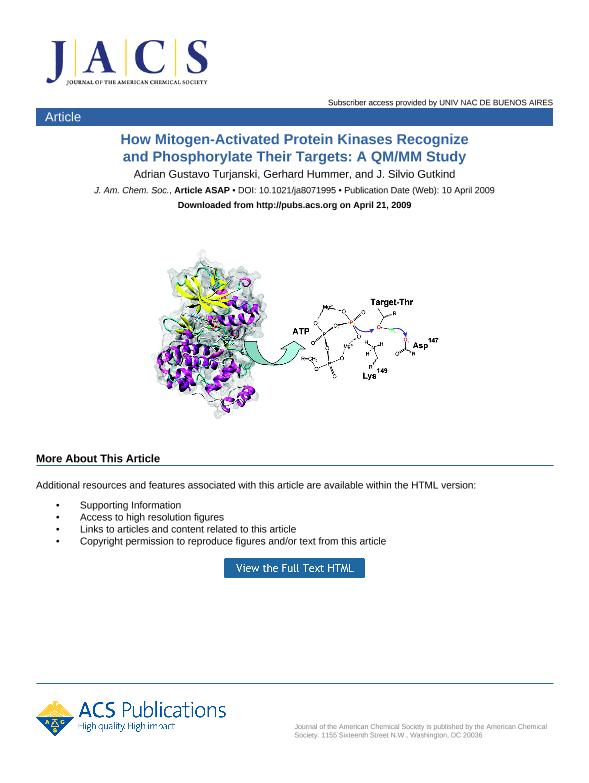Mostrar el registro sencillo del ítem
dc.contributor.author
Turjanski, Adrian

dc.contributor.author
Hummer, Gerhard
dc.contributor.author
Gutkind, J. Silvio

dc.date.available
2019-04-12T22:33:39Z
dc.date.issued
2009-05
dc.identifier.citation
Turjanski, Adrian; Hummer, Gerhard; Gutkind, J. Silvio; How mitogen-activated protein kinases recognize and phosphorylate their targets: A QM/MM study; American Chemical Society; Journal of the American Chemical Society; 131; 17; 5-2009; 6141-6148
dc.identifier.issn
0002-7863
dc.identifier.uri
http://hdl.handle.net/11336/74344
dc.description.abstract
Mitogen-activated protein kinase (MAPK) signaling pathways play an essential role in the transduction of environmental stimuli to the nucleus, thereby regulating a variety of cellular processes, including cell proliferation, differentiation, and programmed cell death. The components of the MAPK extracellular activated protein kinase (ERK) cascade represent attractive targets for cancer therapy, as their aberrant activation is a frequent event among highly prevalent human cancers. To understand how MAPKs recognize and phosphorylate their targets is key to unravel their function. However, these events are still poorly understood because of the lack of complex structures of MAPKs with their bound targets in the active site. Here we have modeled the interaction of ERK with a target peptide and analyzed the specificity toward Ser/Thr-Pro motifs. By using a quantum mechanics/molecular mechanics (QM/MM) approach, we propose a mechanism for the phosphoryl transfer catalyzed by ERK that offers new insights into MAPK function. Our results suggest that (1) the proline residue has a role in both specificity and phospho transfer efficiency, (2) the reaction occurs in one step, with ERK2 Asp 147 acting as the catalytic base, (3) a conserved Lys in the kinase superfamily that is usually mutated to check kinase activity strongly stabilizes the transition state, and (4) the reaction mechanism is similar with either one or two Mg 2+ ions in the active site. Taken together, our results provide a detailed description of the molecular events involved in the phosphorylation reaction catalyzed by MAPK and contribute to the general understanding of kinase activity.
dc.format
application/pdf
dc.language.iso
eng
dc.publisher
American Chemical Society

dc.rights
info:eu-repo/semantics/openAccess
dc.rights.uri
https://creativecommons.org/licenses/by-nc-sa/2.5/ar/
dc.subject
Mapks
dc.subject
Qm/Mm
dc.subject
Docking
dc.subject
Reactivity
dc.subject.classification
Otras Ciencias Químicas

dc.subject.classification
Ciencias Químicas

dc.subject.classification
CIENCIAS NATURALES Y EXACTAS

dc.title
How mitogen-activated protein kinases recognize and phosphorylate their targets: A QM/MM study
dc.type
info:eu-repo/semantics/article
dc.type
info:ar-repo/semantics/artículo
dc.type
info:eu-repo/semantics/publishedVersion
dc.date.updated
2019-03-27T17:54:41Z
dc.journal.volume
131
dc.journal.number
17
dc.journal.pagination
6141-6148
dc.journal.pais
Estados Unidos

dc.description.fil
Fil: Turjanski, Adrian. National Institutes of Health; Estados Unidos. Consejo Nacional de Investigaciones Científicas y Técnicas. Oficina de Coordinación Administrativa Ciudad Universitaria. Instituto de Química, Física de los Materiales, Medioambiente y Energía. Universidad de Buenos Aires. Facultad de Ciencias Exactas y Naturales. Instituto de Química, Física de los Materiales, Medioambiente y Energía; Argentina
dc.description.fil
Fil: Hummer, Gerhard. National Institutes of Health; Estados Unidos
dc.description.fil
Fil: Gutkind, J. Silvio. National Institutes of Health; Estados Unidos
dc.journal.title
Journal of the American Chemical Society

dc.relation.alternativeid
info:eu-repo/semantics/altIdentifier/url/http://pubs.acs.org/doi/abs/10.1021/ja8071995
dc.relation.alternativeid
info:eu-repo/semantics/altIdentifier/doi/http://dx.doi.org/10.1021/ja8071995
Archivos asociados
